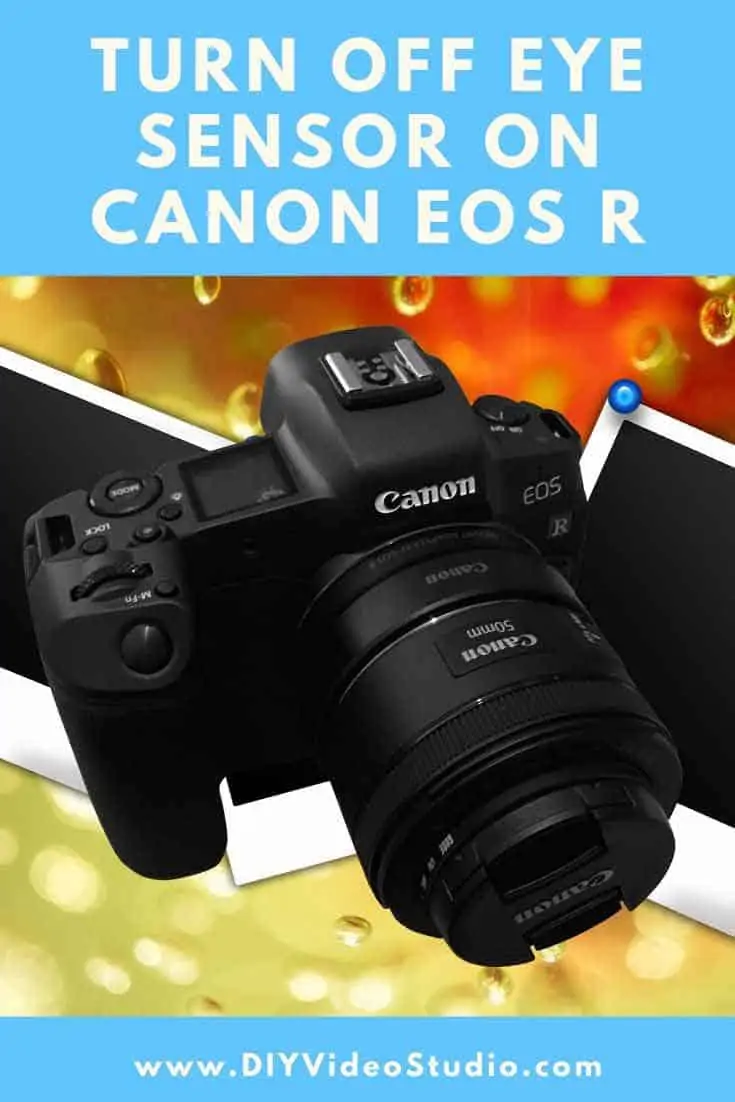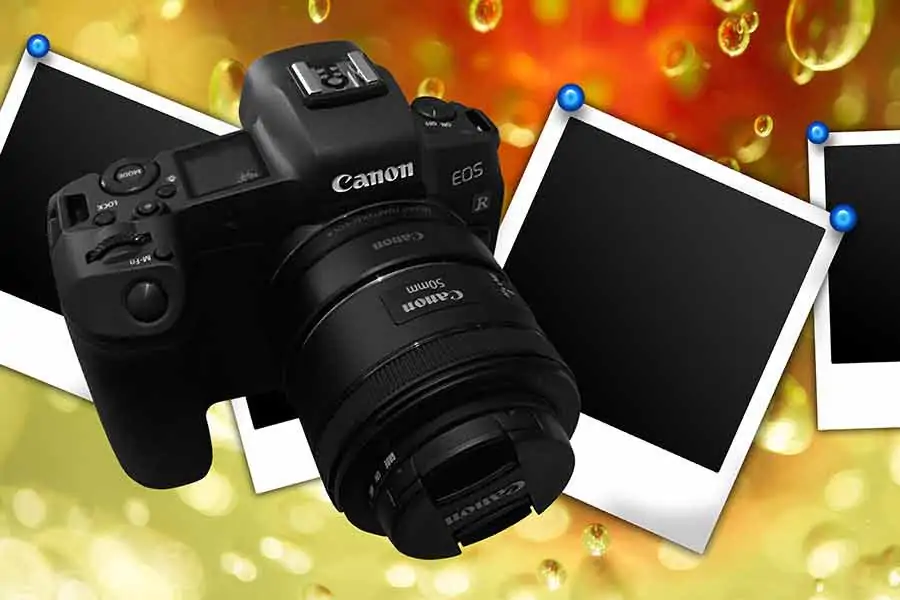DIY Video Studio is supported by its readers. Please assume links on this site are affiliate links or ads, and that I get commissions for purchases made through these links. As an Amazon Associate, I earn from qualifying purchases. Thank you if you use any of the links.
Turn off the EOS R eye sensor
If you want to turn off the EOS R eye sensor on this Canon digital mirrorless camera to stop the screen from turning off whenever you or another object comes close to the viewfinder, here’s what to do.
1. Press the Menu button just below the on/off switch.
2. Tap the wrench icon.
3. Select page 4 of the wrench menu.
4. Tap Display settings.
5. Tap Display control and choose Manual instead of Auto.
6. Tap Manual display and select Screen.
7. Press the Menu button twice to exit the menu display.
The electronic viewfinder on your Canon EOS R mirrorless camera will now be disabled and you can use the camera’s LCD screen for your video shoot without the screen turning off whenever you or another object get too close to the viewfinder proximity sensor.
If you want to jump straight to the step-by-step guide of how to stop the Canon EOS R screen from turning off while filming, click here.

Why is the EOS R screen turning off?
If you look just below the viewfinder of the Canon EOS R mirrorless digital camera you will see a small dark shiny rectangle. It looks not unlike the window over infrared emitters on remote controls.
However, on the EOS R, it is the viewfinder sensor or proximity sensor. It is designed to detect your face as you put your eye up to the electronic viewfinder.
It effectively tells the camera when to automatically turn off the LCD screen when you are looking through the viewfinder.
Having it built-in to the camera makes a lot of sense. Obviously, while you’re looking through the viewfinder you do not need the screen to be powered on.
By blanking the screen battery power is conserved. It will also prevent peripheral light from the screen distracting you when shooting at night or in low light level situations.
When you don’t want your camera screen to turn off
Say you don’t want your camera screen to go blank. Perhaps, like me, you don’t generally use the electronic viewfinder when filming.
Of course, there are times when using the viewfinder makes sense, like shooting outdoors on a sunny day when the screen is difficult to see clearly. I tend to use the screen most of the time.
That’s especially true when using the touch screen to quickly change focus points. So, when using the screen to watch what’s being recorded the last thing you want is for the screen to go blank.
You’d think that if you’re not using the viewfinder there won’t be a problem with the screen turning off.
After all, it’s when I bring my eye up to the viewfinder that the display switches from the screen to the viewfinder.
The problem is the viewfinder sensor is a proximity sensor, it doesn’t care whether it’s detecting my face or any other nearby object.
For instance, it can detect my hand, a mug, or a piece of clothing. When it senses something close by it switches the display from the screen to the viewfinder. So, I don’t need to bring the camera’s viewfinder to my eye for the sensor to detect me.
The first time I used my EOS R on a commercial video job it was at a paper recycling plant.
At one point I needed to shoot a tilt-up on the front of a cardboard baling machine. Now had I done the shot hand-held using the viewfinder I wouldn’t have had a problem.
But I had the camera on a tripod and my back was against a wall. Every time I got the camera tilted back by about 45 degrees the screen went blank.
I could see the display had switched to the viewfinder, so I thought something was wrong with my camera.
The real problem was I hadn’t spent enough time reading the manual or checking out the camera’s menu settings. Talking of which, here’s the download link for the latest EOS R Advanced User Guide.
How to stop the EOS R camera screen turning off
To turn off the eye sensor on the Canon EOS R and stop the screen turning off when shooting video, do the following.
Press the Menu button just below the on/off switch.
Tap on the wrench icon.
Select page 4 of the wrench menu.
Then tap Display settings.
Tap Display control and choose Manual instead of Auto.
Now tap on Manual display and select Screen.
Finally, press the Menu button twice to get out of the menu display and back to your normal camera operation.
The electronic viewfinder on your Canon EOS R mirrorless camera will now be disabled and you can use the camera’s LCD screen for your video shoot without the screen turning off whenever you or another object get too close to the viewfinder proximity sensor.
Job done!
But hang on. Sometimes being able to use the viewfinder during a video shoot is useful. It is great to have the ability to quickly switch between the screen and the viewfinder.
Perhaps the screen is difficult to see properly because of the sun. Alternatively, maybe you want to shoot at night without the screen lighting you up as a distraction behind the camera. With the Canon EOS R mirrorless digital camera, it’s not a problem.
How to switch between the viewfinder and screen
You can easily toggle between the viewfinder and screen by customizing the button of your choice. It’s mentioned on page 558 of the Canon EOS R Advanced Users Guide.
The button I customized for toggling between viewfinder and screen is the M-Fn or Multi-Function button.
It’s conveniently positioned on the top of the camera body, just up from the shutter button. It’s also the quickest button to customize since it’s the first in the camera’s button customization list (at least for video).
Customize the multi-function button
Here is how to customize the multi-function button to toggle the display between the viewfinder and screen.
Press the Menu button just below the on/off switch.
Tap on the Customize icon (the camera icon nearest the right).
Select page 4 of the orange customize menu.
Then tap Customize buttons.
Under the video column select M-Fn
Scroll down and choose Switch between VF/screen (the icon is an oval screen between two vertical lines).
Now tap on SET OK
Finally, press the Menu button twice to get back out of the menu display and your normal camera operation.
Quick Canon EOS R mirrorless camera viewfinder hack
So, you manually selected the screen as your display in the wrench menu but say you didn’t customize a button to toggle between the viewfinder and screen. But what if you happen to be in a situation where you’d like to switch to the viewfinder only.
If you want quick access to the electronic viewfinder here’s what to do. Simply flip the LCD screen over and snap it into the back of the camera body. The display will automatically switch to the viewfinder and the screen will turn off.
If you’re looking for the Canon EOS R video specs, I have written a quick guide. You can read it here.
Canon EOS R Quick FAQ
How to turn off the EOS R eye sensor
1. Press the Menu button just below the on/off switch.
2. Tap the wrench icon.
3. Select page 4 of the wrench menu.
4. Tap Display settings.
5. Tap Display control and choose Manual instead of Auto.
6. Tap Manual display and select Screen.
7. Press the Menu button twice to exit the menu display.
The electronic viewfinder on your Canon EOS R mirrorless camera will now be disabled and you can use the camera’s LCD screen for your video shoot without the screen turning off whenever you or another object get too close to the viewfinder proximity sensor.
Is Canon EOS R Full Frame?
The Canon EOS R is a full-frame 30.3-megapixel mirrorless digital camera, the first camera to feature Canon’s RF lens mount. It has been compared to the Canon 5D Mk IV and has the same Dual Pixel AF system. In photo mode, it can shoot at 8 fps, or 5fps with continuous autofocus.
Can I use EF lens on EOS R?

EF and EF-S lenses can be used on the Canon EOS R mirrorless camera by using a Canon EF-EOS R mount adapter. Canon provides 4 different adapters, each offers distinctive features, but all are 24mm deep and allow you to use your existing EF and EF-S lenses on an EOS RF mount. They do not have any lens elements so there is no loss of image quality. The standard adapter only allows EF and EF-S lenses to be used on cameras with an RF mount with full functionality. The other three adapters. The next model is the Control Ring Adapter, which adds an extra control ring. The third adapter is a Drop-in Filter Mount Adapter within a drop-in circular polarizing filter. The fourth is a Drop-in Filter Adapter with a drop-in variable ND filter.
Is Canon EOS R weather sealed?
The Canon EOS-R is a weather-sealed camera. The buttons and dials are sealed, and rubber flaps protect the camera’s sockets and connectors. Some of the RF lenses, such as the RF 24-105mm f/4, have weather-sealing gaskets that provide a snug fit of the camera’s mounting ring. The weather sealing does not make the camera waterproof, and additional protection would be necessary for wet conditions.
Does Canon EOS R have WIFI?
The Canon EOS-R has Bluetooth and Wi-Fi connectivity. It will connect with smartphones allowing remote control and the ability to auto-send images to the phone. It can auto send images to computers and web services, as well as print from wi-fi printers.
Tosh Lubek runs an audio and video production business in the UK and has been using the Canon EOS R since it was released in the Autumn of 2018. He has used the camera to shoot TV commercials for Sky TV, promotional business videos, videos of events and functions, and YouTube creator content. He has also won international awards for his advertising and promotional work. You can meet him by visiting his “video booth” at HashTag business events across the country.
Recent Posts
Most people use sandbags the wrong way. Here’s how to hang them properly on a light stand for maximum stability and safety — plus what to fill them with.
You're Using the Canon RF 50mm f/1.8 WRONG! Here’s How to Fix It
If you’ve recently picked up the Canon RF 50mm f/1.8 STM—affectionately known as the Nifty Fifty—you might be confused by that strange switch on the side of the lens. It doesn’t say AF/MF...


